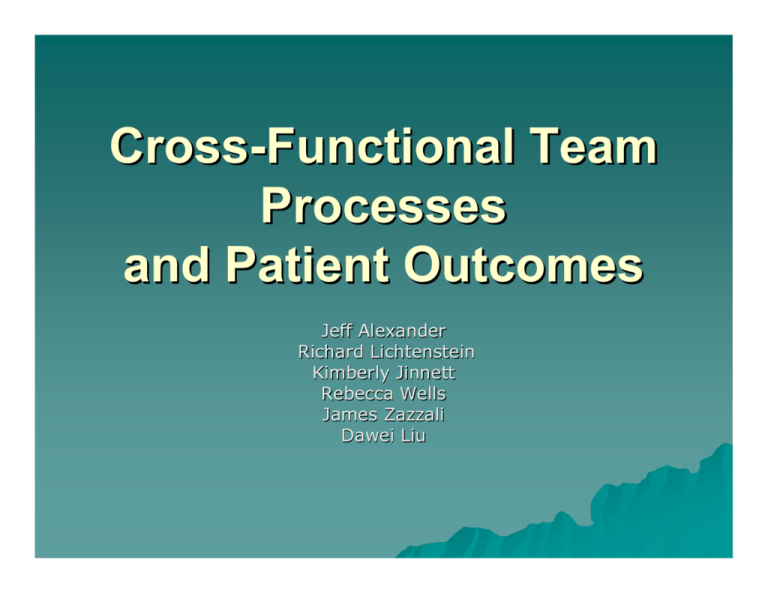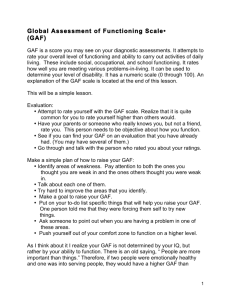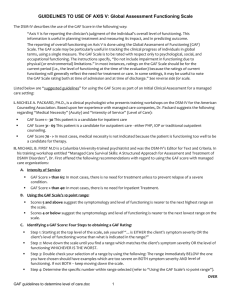Cross-Functional Team Processes and Patient Outcomes
advertisement

Cross-Functional Team Processes and Patient Outcomes Jeff Alexander Richard Lichtenstein Kimberly Jinnett Rebecca Wells James Zazzali Dawei Liu Why Cross Functional Teams? synthesize and apply knowledge from a variety of disciplines Health problems have become more complex with chronic illness Medical training has become more specialized improving the performance of CFTs – IOM CFTs- the normative model individuals from different disciplines who have varied backgrounds and interpretive schemes for analyzing problems Relationships among CFT members are intended to be non-hierarchical all members contribute their knowledge according to situational demands rather than traditional organizational roles CFTs- the evidence more creative solutions better quality decisions increased organizational effectiveness lower turnover rates greater opportunities for learning and professional growth greater sense of empowerment CFTs- the evidence randomized control trials to assess team performance limited understanding of team process quasi-experimental studies of CFT are cross-sectional and focused on structure No objective measures of team performance Team Processes Normative versus the empirical Team embeddedness Status distinctions among professional groups CFTs in Mental Health mainstay of psychiatric care for seriously mentally ill include physicians, nurses (RNs and LPNs), social workers, psychologists, and pharmacists. Therapists (occupational, recreational), dieticians, and chaplains participate on a more selective basis Participation and Team Functioning Participation: extent to which staff members “engage jointly with others” in making patient care decisions Team Functioning: inputs from interdependent members are jointly integrated so that the work of the team flows seamlessly. Sample and Data patient sample: consisted of 1,638 seriously mentally ill patients Organization sample:40 units that cared exclusively for the mentally ill in 16 Veterans Affairs hospitals 40 patient care teams embedded in 40 units Team Characteristics average team: 9.5 members, (range 2 – 38) modal team staff : 1 physician, 1 social worker, 3 registered nurses (RNs), 1 licensed practical nurse (LPN), 2 nurses’ aides, 1 recreational therapist. Data self-administered survey to direct patient care providers – 3 waves shorter survey of unit directors data on unit level characteristics- 3 waves Patient data collected by trained clinicians at regular intervals using a standard instrument- 1 to 14 waves Administrative data on staffing for each sample unit Measures-team level Team Participation- 7 item scale based on an aggregation of individual team members’ participation on each team. Team Functioning- 8 item scale aggregated from individual assessments of how well the treatment team was functioning in coordination, cohesion, and perceived performance Patient cohort functioning, team size Measure 1) Team Participation 2) Team Functioning Scale Items a) b) c) d) e) f) g) a) b) c) d) e) f) I frequently contribute information I frequently interpret information I can comfortably disagree with others I feel free to participate actively I usually propose alternatives I usually evaluate alternatives I frequently participate in making decisions Overall, our team has done its work well this last month In general, our patients receive high quality of care. Members of our team depend on each other to do our jobs We clearly are a team of people with a shared task – not a collection of individuals who have their own particular jobs to do. In general members of our team would agree that we have worked well as a team this past month. Overall, the difference patient-related jobs and activities that everyone does on this team fit together very well. Measures- Patient Level Basic Activities of Daily Living Scale (ADL) Prior Inpatient Days Age Diagnosis-Dementia & alcoholrelated disorders; schizoaffective disorders & schizophrenia; bipolar & major depression. Measures- Time Repeated assessments of ADLcumulative, repeated measure of elapsed time (in days) from program entry to each subsequent ADL assessment Analysis three levels of analysis: time (level 1), individual (level 2), and team (level 3) Multilevel statistical methods account for nested structure of the data (Proc Mixed in SAS) takes account of the level of the outcome variable at program entry, change in outcome status over time, and nesting of clients within treatment teams. Results intraclass correlation (ICC) 37% time level 42% individual level 21% team level. Final Estimation of Fixed Effects of Team Participation on ADL Fixed effect Coefficient S.E. INTRCEPT 0.946 ** (0.408) GAF -0.006 ** (0.003) Team SIZE -0.002 ns (0.003) Team Participation. -0.156 ** (0.063) InptDAYS 0.001 *** (0.0001) Age 0.005 *** (0.001) Dementia 0.176 *** (0.058) Bipolar 0.075 ** (0.027) Time -0.000 ns (0.0003) GAF x Time -2.80E-6 ns (2.49E-6) SIZE x Time -8.87E-7 ns (2.71E-6) Team Part. x Time -0.00012 ** (0.000059) Inpt.DAYS x Time -1.55E-7 *** ( 9.337E-7) AGE x Time 9.17E-6 ns (1.113E-7) Dementia x Time 0.000015 ns (0.000066) Bipolar x Time -0.0001 *** (0.000031) _____________________________________________________________________________ **=p<.05, ***=p<.01; schizophrenia is the reference condition for dementia and bipolar ______________________________________________________________________________ Final estimation of variance components: Random Effect Variance Component INTRCPT1 TIME slope level-1 INTRCPT1/INTRCPT2 TIME/INTRCPT2 0.2851 0.000262 0.07984 0.1472 0.000127 Final Estimation of Fixed Effects of Team Functioning on ADL Fixed effect Coefficient S.E. INTERCEPT 0.692 ** (0.310) GAF -0.006 ** (0.003) Team SIZE -0.002 ns (0.003) Team Functioning. -0.122 ** (0.049) InptDAYS 0.001 *** (0.0001) Age 0.005 *** (0.001) Dementia 0.178 *** (0.058) Bipolar 0.073 ** (0.027) Time -0.000 ns (0.0003) GAF x Time -1.67E-6 ns (2.678E-6) SIZE x Time 1.966E-6 ns (3.008E-6) Team Fct x Time 0.000016 ns (0.000051) Inpt.DAYS x Time -1.59E-7 *** (9.337E-7 ) AGE x Time 9.122E-6 ns (1.113E-7 ) Dementia x Time 0.00000999 ns (0.000066) Bipolar x Time -0.0001 *** (0.000031) _____________________________________________________________________________ **=p<.05, ***=p<.01; schizophrenia is the reference condition for dementia and bipolar Final estimation of variance components: Random Effect Variance Component INTRCPT1, TIME slope level-1 INTRCPT1/INTRCPT2 TIME/INTRCPT2 0.2851 0.000262 0.07984 0.1454 0.000145 ADL impairment 3 2.5 2 low participation 1.5 high participation 1 0.5 0 entry 1 year 5 years Implications importance of the relationship between treatment team processes and patient functional status team design and evaluation must take into consideration the difference between team functioning and team performance other outcomes











